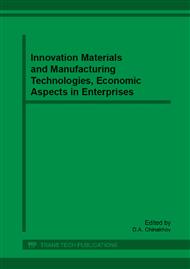p.60
p.66
p.71
p.77
p.82
p.87
p.91
p.95
p.101
Bronze Sealing Rings Defects and Ways of its Elimination
Abstract:
In the article data about application nanopowder on a structure of coatings of the form are submitted at a casting of lead-tin bronzes. Elimination of gas porosity on a surface bronze cast preparations of high pressure compressors piston rings was the primary goal of such application protectively-dividing coverings. For experimental works mark of multicomponent bronze has been chosen. Its structure includes tin, lead, zinc and nickel. Casting from this bronze received a method of centrifugal molding. Influence of a structure of used protective - separating coating of a foundry core on a surface smoothness was probeed. Was compared action of coatings of a following composition: anti-burning-in coating (a blend of a low dispersible powder of chromium oxide with calcinated vegetable oil); anti-burning-in material ASPF-2/RgU (on the basis a low dispersible powder of graphite and the calcinated vegetable oil); the patent № 2297300 (blend of a ultradispersible powder of dioxide of zirconium with inpowderrial oil. Molding without use of coverings leads porosity depth to 4-5 mm and to a marriage significant amount (to 50 %). Use ASPF-2/RgU completely eliminates welding casting to a casting mold, but porosity on a surface remains. Application of coverings of a casting mold containing in quality of a filler ultradisperse powders oxide metals with low heat conductivity allows in to lower much a roughness and to eliminate gas porosity on a cast surface from lead-tin bronze. A gas time of a surface still remains, but them becomes much less and their form changes. Depth of defects doesn't exceed 1-1,5 mm that doesn't fall outside the limits the admission.
Info:
Periodical:
Pages:
82-86
Citation:
Online since:
August 2013
Authors:
Keywords:
Price:
Сopyright:
© 2013 Trans Tech Publications Ltd. All Rights Reserved
Share:
Citation:


